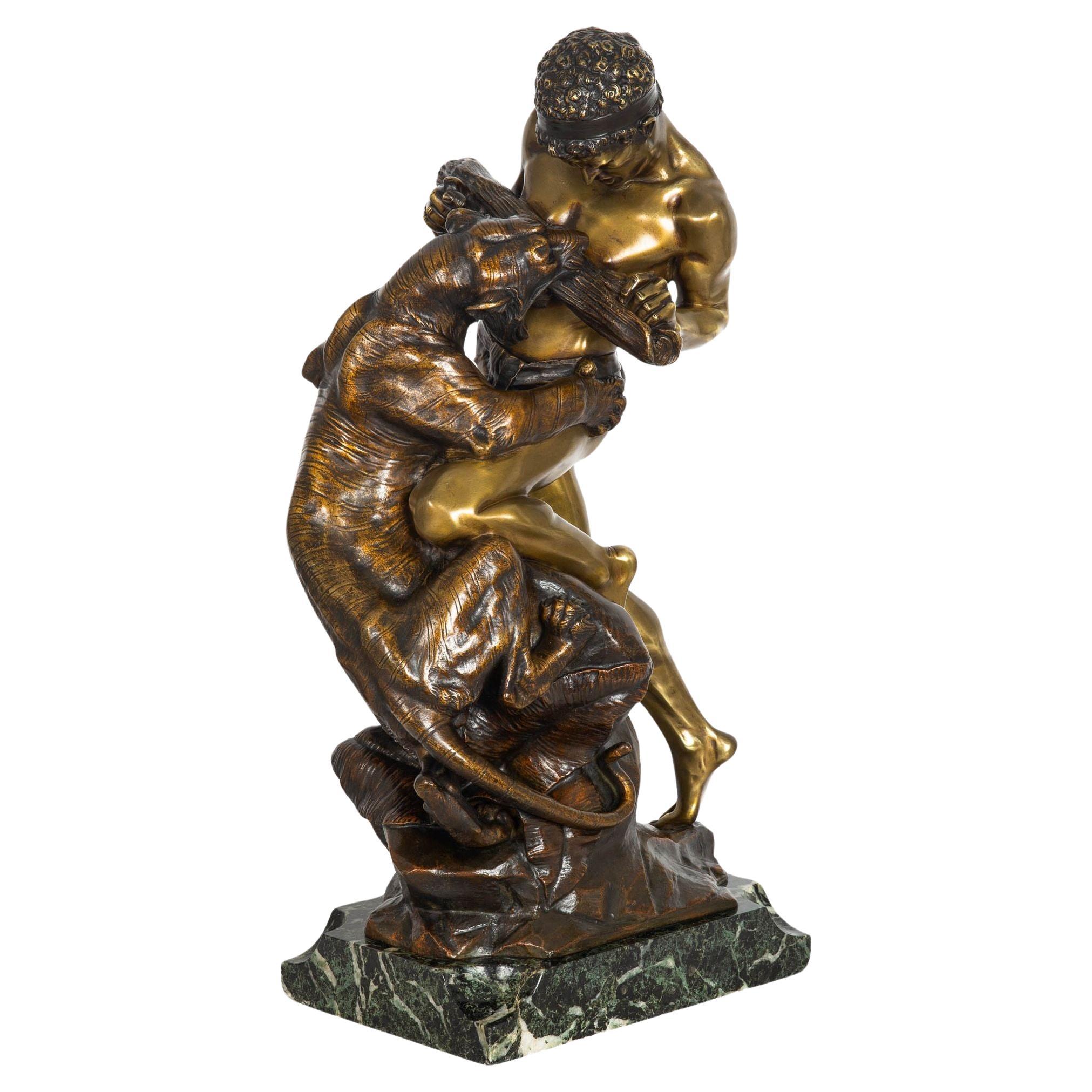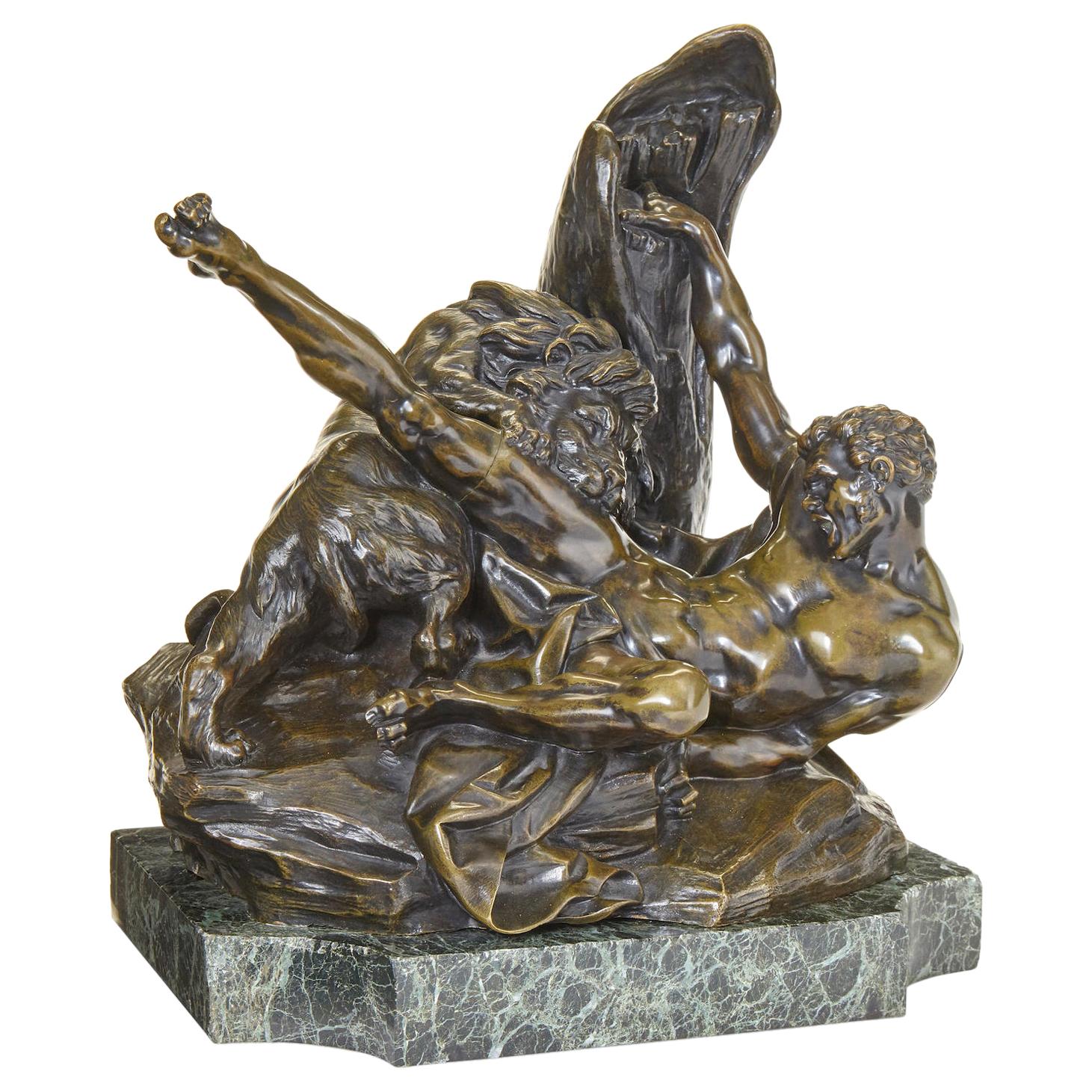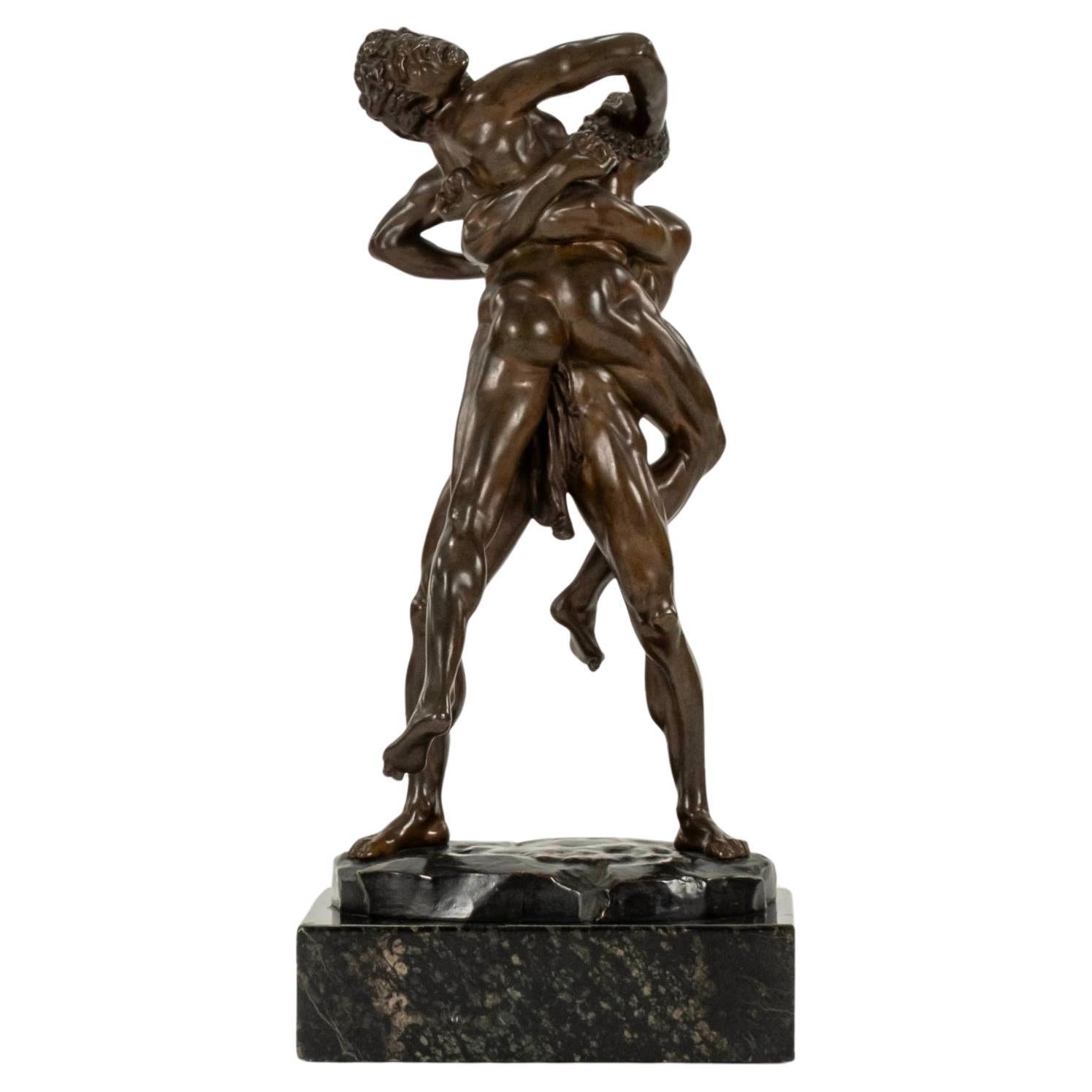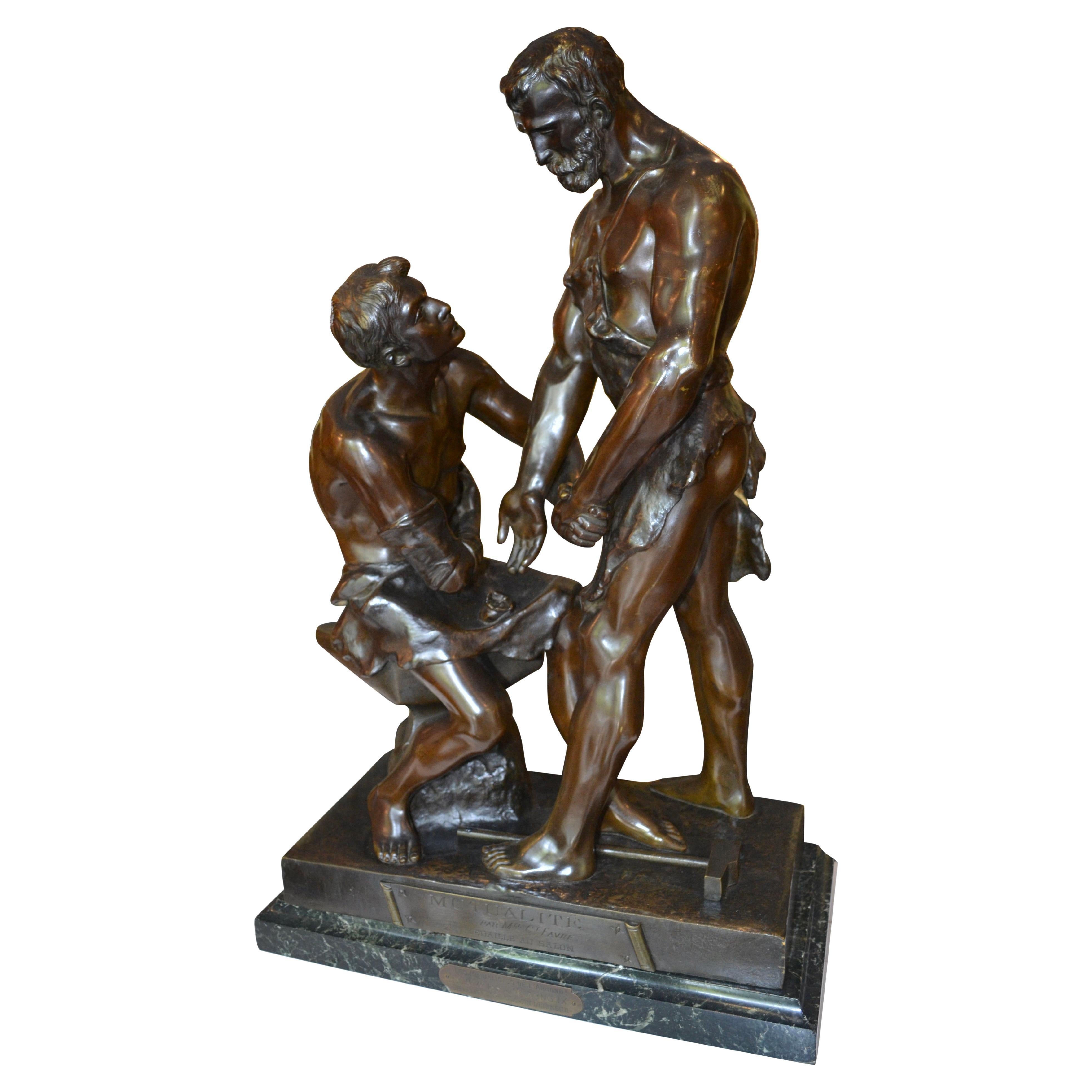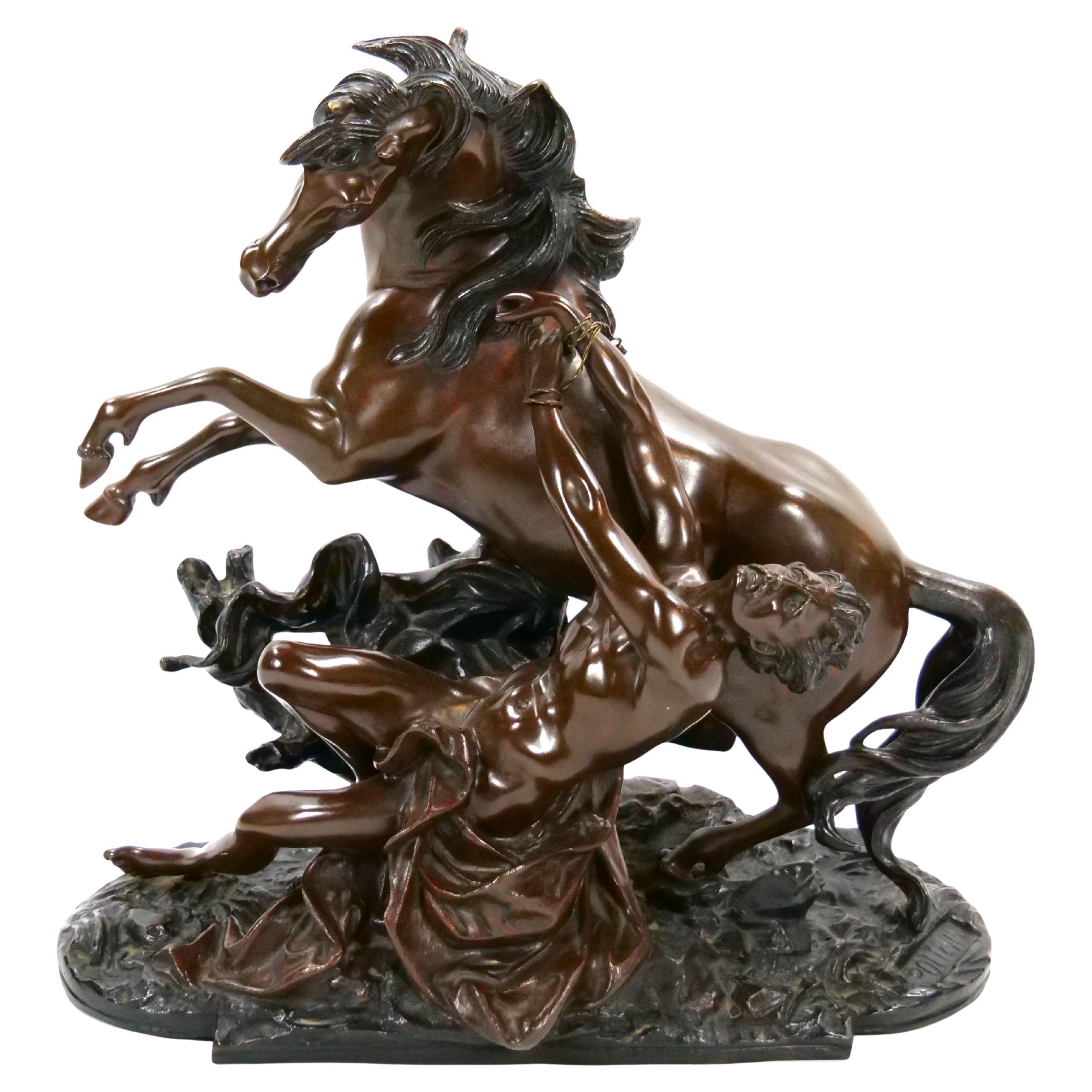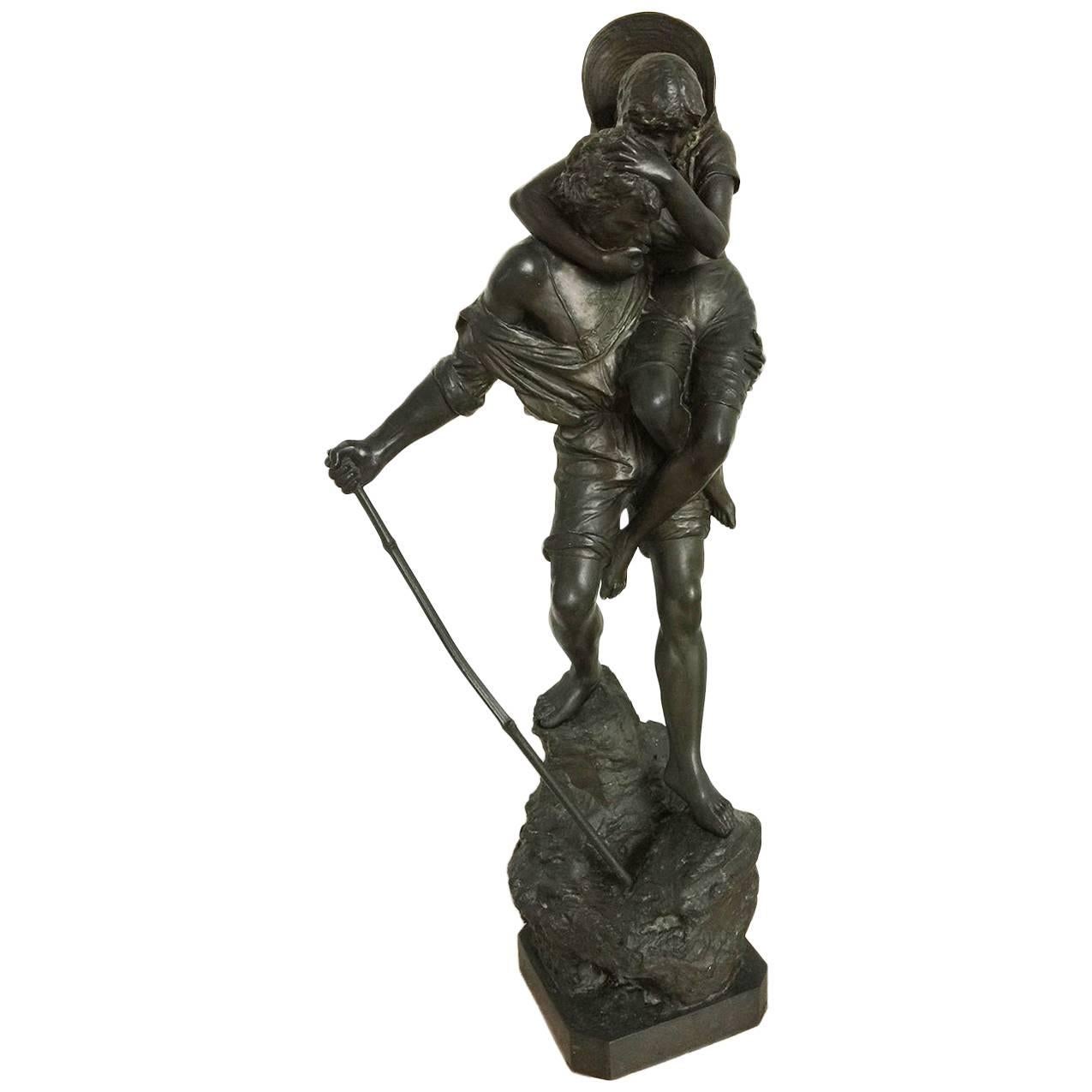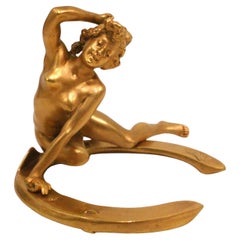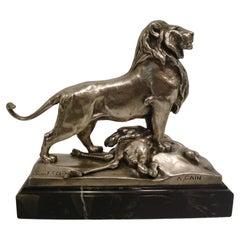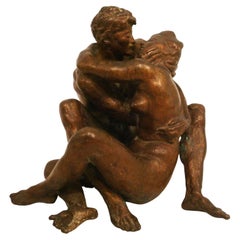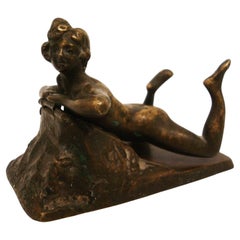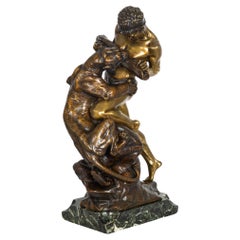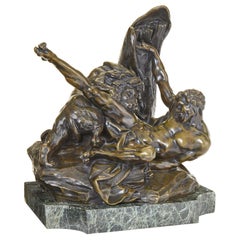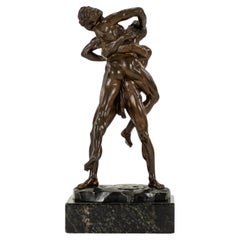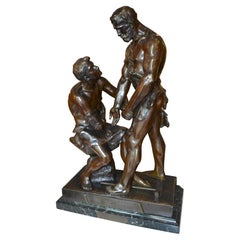Items Similar to 19th Century, Silvered Bronze Sculpture with the Struggle for Life by E. Drouot
Want more images or videos?
Request additional images or videos from the seller
1 of 14
19th Century, Silvered Bronze Sculpture with the Struggle for Life by E. Drouot
$2,299
£1,743.23
€2,000.08
CA$3,271.20
A$3,548.51
CHF 1,866
MX$43,178.17
NOK 23,328.05
SEK 22,001.22
DKK 14,933.16
About the Item
Edouard Drouot (1859-1945), The struggle for life (La Lutte pour la Vie), Silvered Bronze and Green marble sculpture
Signed "E. Drouot"
This valuable bronze-silvered sculpture is the work of the French sculptor Edouard Drouot (1859-1945) and depicts La The struggle for life (La Lutte pour la Vie). It is the representation of a man with a statuary and classicist physique, dressed only with a thong, while struggling with a fierce panther, climbing on a rocky group. Some identify the man Milone of Crotone, ancient Greek wrestler and Olympic champion, who lived in the second half of the sixth century BC, famous for his incredible strength. The sculptural ensemble is of great expressive power. It rests on a green marble base.
Édouard Drouot is a French sculptor born in Sommevoire on 3 April 1859 and died in Paris on 22 May 1945. He is a pupil of Émile Thomas and Mathurin Moreau and has been exhibiting at the Paris Salon since 1889. He was awarded the Third Class Medal in 1892. He participated in the Universal Exhibition in 1900 in Paris with L'amateur, where he obtained an honorable mention. Known for its marble and bronze sculptures depicting mythological and allegorical scenes, it also depicts animals and oriental subjects. The sculptures of Drouout are characterized by a strong sense of movement and expressive touch. Some of his works are now preserved in the collections of the Courtauld Institute in London and the Indiana University Art Museum in Bloomington, among others.
The beautiful bronze quality and the perfect state gives this sculpture a very decorative, a pleasant usability. Perfect Desk sculpture.
We have specialized in the sale of Art Deco and Art Nouveau and Vintage styles since 1995. If you have any questions we are at your disposal. Pushing the button that reads 'View All From Seller'. And you can see more objects to the style for sale. Why are there so many antiques in Argentina?
In the 1880 – 1940 there was a grate wave of immigration encouraged by the periods of war that were taking place. 1st World War took place between 1914 and 1918 2nd World War took place between 1939 and 1945 The immigrants options were New York or Buenos Aires. Tickets were cheap and in Buenos Aires they were welcomed with open arms, as it was a country where everything was still to be done. Argentina was the country of new opportunities, labour was needed and religious freedom was assured, in many cases the of the family travel first until they were settled and then the rest of the family members join them. In the immigrant museum “Ellis Island Immigrant Building” in New York you can se the promotional posters of the boats that would take them to a new life. Between the years 1895 and 1896, Argentina had the highest DGP (gross domestic product) per capita in the world according to the Maddison Historical Statistics index, this situation arose due to the large amount of food being exported to European countries, which were at war. The Argentinean ships left the port of Buenos Aires with food, but they returned with furniture, clothes and construction elements, (it´s common to see this the old buildings of the historic neighbourhood of San Telmo, the beams with the inscription “Made in England)”, as well as many markets that were built in Buenos Aires, such us the San Telmo Market, whose structure was brought by ship and afterwards assembled in 900 Defensa Street. With the great influence of European immigrants living in the country, the children of the upper classes travelled to study in France, resulting in the inauguration of “La Maison Argentinienne”, on 27th of June 1928, in the international city of Paris, which hosted many Argentinians that were studying in Frace. It´s the fourth house to be built after France, Canada and Belgium, being the first Spanish-speaking one. Still in place today (17 Bd Jourdan, 75014, Paris, France). Many of the children of these wealthy families who attended international art exhibitions, museums and art courses abroad, took a keen interest in the European style. This is why Buenos Aires was at the time referred as “The Paris of South America”. Between the years 1890 and 1920 more than a hundred Palaces were built on Alvear Avenue the most exclusive avenue in Buenos Aires. Today some of these palaces have been transformed into museums, hotels and embassies. In the year 1936, the Kavanagh building was inaugurated, it was the tallest reinforced concrete building in South America. During 1994 the American Society of Civil Engineers distinguished it as an “international engineering milestone”, and it´s now considered a World Heritage of Modern Architecture. At the time was common to hire foreign architects such as Le Corbusier, who visited Buenos Aires/Argentina in 1929 and in 1948 he drew up the blueprints for a house built in La Plata City (which was declared a World Heritage Site). In 1947, the Hungarian architect Marcelo Breuer designed “Parador Ariston” in the seaside city of Mar del Plata. After an Argentinean student at Harvard University convinced him to come to Argentina. He worked on an urban development project in the Casa Amarilla, area of La Boca. The Ukrainian architect, Vladimiro Acosta, arrives in Argentina in 1928 and worked as an architect until que moved to Brazil. Antonio Bonet, a Spanish architect who worked with Le Corbusier in Paris, arrives in Argentina in 1937, where he carried out several architectural works and in 1938 designs the well-known BFK chair. Andres Kálnay, of Hungarian origin, made around 120 architectural masterpieces, among which the former Munich brewery stands out, he even made the furniture’s design. The German architect, Walter Gropius, director of the Bauhaus, lived in Argentina, where he wrote articles for “Sur” magazine and founded in Buenos Aires, an architectural firm with Franz Möller, who was also an architect, where he built two houses. At the same time several famous designers decided to immigrate to Argentina, among them we can find the well-known French designer, Jean-Michel Frank, who arrived in the country in 1940 and also worked for the Rockefeller family. Special pieces were made, which were sold exclusively in the country, such as the well-known German company “WMF”, who sold their products by catalogue, which were chosen by the ladies of high society in the list of wedding gifts, as well as the pieces designed by Christofle. The Swiss sculptor Alberto Giacometti, made special pieces for Argentinean mansions. In 1904 the first Jansen branch outside Paris was established in Buenos Aires, as the Argentinean clientele demanded a large amount of furniture, from the end of the 19th century to the mid-20th century. In 1970, the brand Rigolleau Argentina made pieces authorised by Lalique. The brands Maple and Thompson also set up shop in the country. The French plastic artist, Marcel Duchamp moved to Argentina in 1918-1919. Glass signed Gallé, Charder, Leverre, Schneider, Muller and other French firms. They were bought in flower shops and were given to ladies with beautiful floral arrangements. Some furniture manufacturers travelled to international fairs and bough the patterns to produce the furniture in Argentina, such as the furniture firm Englander and Bonta, who bought the patterns in Italy. It is worth mentioning that in Argentina we have the largest community of Italians outside of Italy, as it is estimated that 70 percent of the inhabitants have at least one Italian descendant, followed by Spanish immigrants. The most Important furniture stores in Argentina: Comte is founded in 1934 (under the direct management of Jean Michel Frank in 1940). Nordiska (Swedish company established in 1934). Churba in 1960, a company that brought foreign designers to present their furniture in the country: Denmark: (Arne Jacobsen, Finn Juhl, Bender Madsen, Ejner Larsen, Poul Kjaerholm, Hans Wegner) Sweden: (Hans Agne Jakobsson, Gustavsberg) United States: (Herman Miller) Finland: (Lisa Johansson, Folke Arstrom, Tapio Wirkkala, Alvar Aalto, Timo Sarpaneva) Swedish Factory: (Orrefors) Italy: (Littala, Vico Magistretti, Emma Gismondi, Gae Aulenti, Angelo Mangiarotti, Elio Martinelli, Gianna Celada, Angelo Mangiarotti, Mario Bellini, Carlo Scarpa) Finland: (Olivia Toikka) Plata Lappas (Lappas Silver): a goldsmith shop founded in 1887 in Argentina by Alcibiades Lappas of Greek origin. In 2019, in Argentina took place “the Art Deco world congress” . Argentina currently has more than 100 Art Deco buildings and another 90 Art Nouveau buildings throughout the city of Buenos Aires. Argentina is a country that has not been involved in many wars, which is why it has been a refuge for works of art and antiques from different periods of time, unlike European countries. That is way many collectors, museums and antique dealers from all over the world visit it, you should not miss the opportunity to visit this great country.
- Creator:Edouard Drouot (Artist)
- Dimensions:Height: 10.63 in (27 cm)Width: 5.44 in (13.8 cm)Depth: 4.14 in (10.5 cm)
- Style:Classical Greek (In the Style Of)
- Materials and Techniques:
- Place of Origin:
- Period:
- Date of Manufacture:1880
- Condition:Wear consistent with age and use.
- Seller Location:Buenos Aires, AR
- Reference Number:1stDibs: LU2027331556572
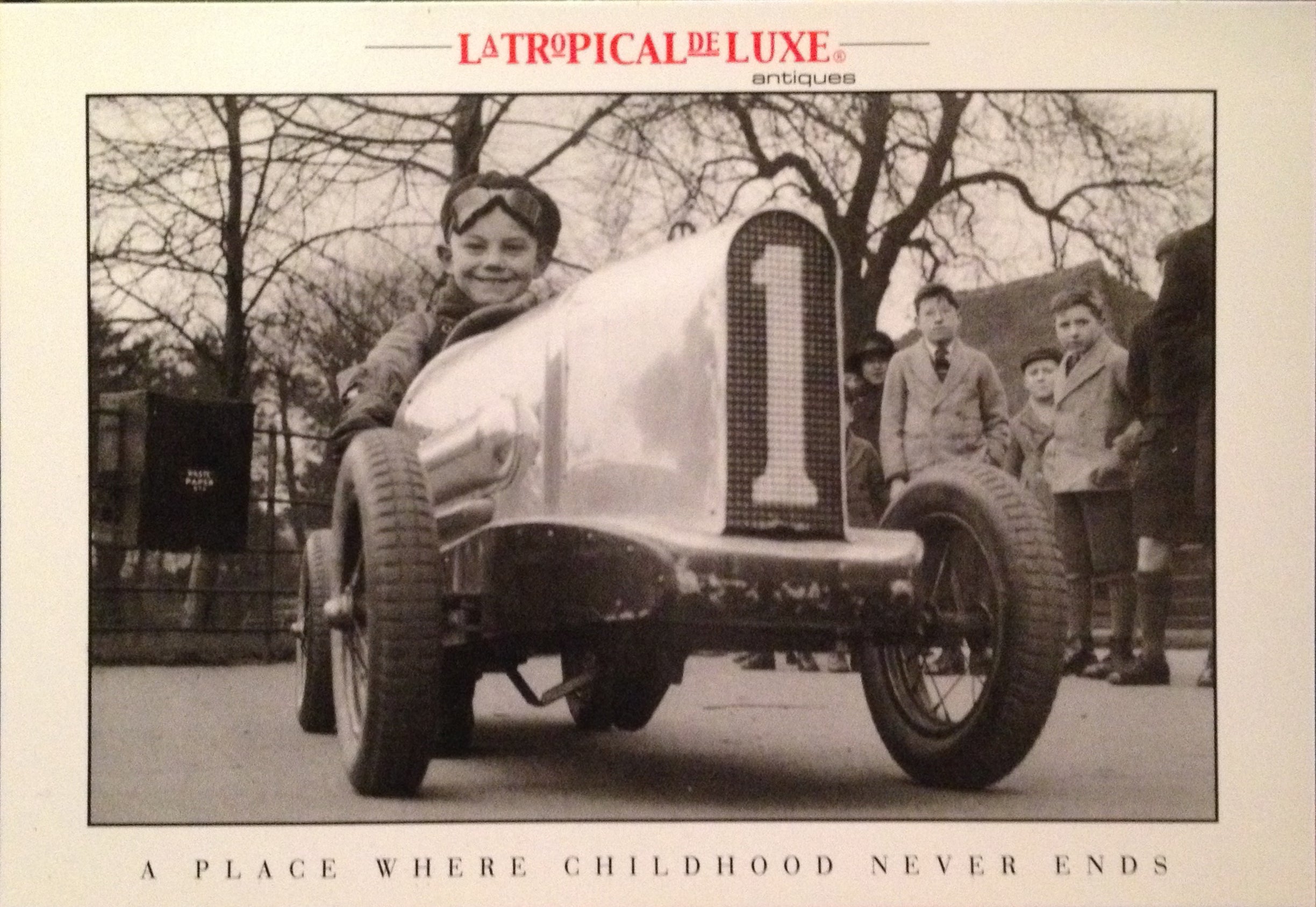
About the Seller
4.9
Vetted Professional Seller
Every seller passes strict standards for authenticity and reliability
Established in 2002
1stDibs seller since 2016
324 sales on 1stDibs
Typical response time: <1 hour
- ShippingRetrieving quote...Shipping from: Buenos Aires, Argentina
- Return Policy
Authenticity Guarantee
In the unlikely event there’s an issue with an item’s authenticity, contact us within 1 year for a full refund. DetailsMoney-Back Guarantee
If your item is not as described, is damaged in transit, or does not arrive, contact us within 7 days for a full refund. Details24-Hour Cancellation
You have a 24-hour grace period in which to reconsider your purchase, with no questions asked.Vetted Professional Sellers
Our world-class sellers must adhere to strict standards for service and quality, maintaining the integrity of our listings.Price-Match Guarantee
If you find that a seller listed the same item for a lower price elsewhere, we’ll match it.Trusted Global Delivery
Our best-in-class carrier network provides specialized shipping options worldwide, including custom delivery.More From This Seller
View AllGeorges Récipon, "Lucky", Gilt Patina Bronze Sculpture / Desk Paperweight
By Georges Récipon, Susse Freres
Located in Buenos Aires, Olivos
Georges Récipon, "Lucky", Gilt Patina Bronze Sculpture / Desk Paperweight. Signed and dated.
Beautiful bronze sculpture (gold patina) representing a naked woman nailed a horseshoe, ...
Category
Antique 1890s French Art Nouveau Figurative Sculptures
Materials
Bronze
Auguste Cain Silvered Bronze Lion & Ostrich Sculpture 19th Century.
By Susse Freres, Auguste Nicholas Cain
Located in Buenos Aires, Olivos
Auguste Cain Silvered Bronze Lion & Ostrich (1822-1894). This fine bronze shows a male lion standing proud, his front right foot is perched on a rock and his left stands firmly on his pray, an ostrich; he has a full mane and a curling tail, has good detail in the fur and the feathers of the ostrich. Signed "A. Cain" and a foundry mark. Perfect Size to locate on a desk.
Auguste Nicholas Cain (1821 – 1894) was a Paris born French sculptor in the Animaliers school who was known for his bronze sculptures...
Category
Antique Late 19th Century French Empire Animal Sculptures
Materials
Bronze
Mid-century Nude Lovers Bronze Sculpture Statue By Francesco Messina
By Francesco Messina
Located in Buenos Aires, Olivos
Fantastic Sculpture of a couple of naked lovers kissing, Both nude.
Perfect size, will go perfect in any space.
Francesco Messina (15 December 1900 – 13 September 1995) was an Italian sculptor of the 20th century.
Francesco Messina was born at Linguaglossa in the Province of Catania in a very poor family. Growing up in Genoa, where he also studied and lived until he was 32, he then moved to Milan.
Art historians consider him one of the most important figurative sculptors of Novecento, together with Giacomo Manzù, Arturo Martini, Marino Marini. He is the author of some of the greatest works of the Novecento Italiano[citation needed] and his sculptures are displayed in the most famous museums, among which: Bern, Zürich, Gothenburg, Oslo, Munich, Paris, Barcelona, Berlin, São Paulo, Buenos Aires, Venice, Moscow, Saint Petersburg, Vienna, Washington, D.C. and Tokyo.
From 1922, he began exhibiting his work regularly at the Biennale Internazionale d'Arte in Venice and between 1926 and 1929 he took part in the expos organised by the art group Novecento Italiano in Milan. In 1932, he moved to Milan, where in 1934 he obtained a tenured professorship 1934 in Sculpture at the Accademia di Belle Arti di Brera, of which he became the director within two years.
During those years, about him wrote Carlo Carrà:
Francesco Messina's sculpture is characterised by a simple and grandiose manner, by an idealistic and classic procedure, able to give life to forms which become "ideal images".
In the 1930s, Messina exhibited at important collective expos of Italian art in Barcelona, Berlin, Bern, Gothenburg, Munich, Oslo, Paris, São Paulo, Zurich, while executing various sculptures in many Italian cities. In 1936 he was appointed director of the Accademia di Brera, which position he will keep until 1944. His work was also part of the sculpture event in the art competition at the 1936 Summer Olympics.[
In 1938, Giorgio de Chirico in Rome and Salvatore Quasimodo in Turin presented two personal exhibitions of Messina's work. In 1942 he won the Sculpture Prize at the XXIII Biennale Internazionale d’arte of Venice, where he exhibited fifteen sculptures and seventeen drawings.
In 1943, Messina was appointed Academic Emeritus of Italy. On the collapse of the fascist regime, he was temporarily dismissed from the academy, only because he had been its director during the fascist period. However, by 1947 he had already regained his professorship. In the same period the artist took part in the Graphic & Sculpture Expo at Buenos Aires, in the Muller Gallery, achieve a noticeable success. In 1949 he exhibited at the 3rd Sculpture International held by the Philadelphia Museum of Art in Philadelphia, together with Marino Marini and Picasso.
Romantica, c. 1973 (Fondazione Cariplo)
In 1956 he participated with a personal exhibition at the XXVIII Biennale di Venezia. In 1963 he produced the great monument to Pope Pius XII for St. Peter's Basilica in the Vatican, as well as the bust of Pietro Mascagni for the Teatro alla Scala. In the same year he was awarded the Michelangelo Prize for Sculpture in Florence.
In 1966 Messina was commissioned by Italian RAI to create the Cavallo morente (Dying Horse...
Category
Mid-20th Century Italian Mid-Century Modern Figurative Sculptures
Materials
Bronze
$2,660 Sale Price
30% Off
Erotic - Nude Woman Viena Bronze Sculpture / Desk Paperweight. Austria 1900´s
By Franz Bergmann
Located in Buenos Aires, Olivos
Erotic - Nude Viena Bronze Sculpture / Paperweight. Austria 1900´s.
Lovely woman nude paperclip or paperweight.
We have specialized in the sale of Art Deco and Art Nouveau and Vinta...
Category
Early 20th Century Austrian Art Nouveau Paperweights
Materials
Bronze
Silvered Bronze Bookends Sculptures of a Mermaid and Merman, France, 1900
By Jean Garnier
Located in Buenos Aires, Olivos
Silvered bronze bookends sculptures of a Mermaid and Merman, France, 1900.
This enchanting bronze sculpture is the object of many sailors dreams. Silvered bronze sculptures of a merm...
Category
Early 20th Century French Art Nouveau Figurative Sculptures
Materials
Bronze
Leda and the Swan Bronze sculpture by Ferd Otratovsky
Located in Buenos Aires, Olivos
Leda and the Swan Bronze sculpture by Ferd Otratovsky.
Signed and dated "FERD. OTRADOVSKY 1926" within the cast on the base.
Black patinated bronze, mounte...
Category
Early 20th Century French Art Nouveau Figurative Sculptures
Materials
Marble, Bronze
You May Also Like
“Lutte pour la vie” Scarce French Bronze Sculpture by Edouard Drouot
By Edouard Drouot
Located in Shippensburg, PA
EDOUARD DROUOT
French, 1859-1945
"Lutte pour la vie" [A fight to survive]
Patinated and polychromed bronze on verde marble signed "E. Drouot” cast circa 1920
Item # 311GTN28A
A ve...
Category
20th Century French Romantic Animal Sculptures
Materials
Marble, Bronze
Fine French 19th Century Bronze Figure of "Milo of Croton & Lion" After Falconet
By Étienne Maurice Falconet
Located in Los Angeles, CA
A very fine French 19th century Patinated bronze Figure of "Milo of Croton and the Lion" after the marble sculpture of Milon de Crotone by renown French...
Category
Antique 19th Century French Baroque Figurative Sculptures
Materials
Marble, Bronze
$12,450 Sale Price
32% Off
Hercules Antaeus Bronze Sculpture by Carl Kauba
By Carl Kauba
Located in Houston, TX
Bronze Sculpture of Hercules and Antaeus crafted and signed by Carl Kauba. This sculpture depicts the tale of Hercules' battle against Antaeus.
Antaeus, son of Gaia and Poseidon,...
Category
Antique 19th Century Austrian Figurative Sculptures
Materials
Marble, Bronze
Rare 19 Century Bronze Statue Titled "Mutualite" by Maurice Constant Favre
By Maurice Constant Favre
Located in Vancouver, British Columbia
A very rare and beautifully cast late 19th century bronze by Maurice Constant Favre (1875-1915), titled " Mutualite" depicting two bare chested muscular blacksmiths, an older stockie...
Category
Antique Late 19th Century French Romantic Figurative Sculptures
Materials
Bronze
French 19th Century Bronze Sculpture of Hippolytus After Philippe Poitevin 1831
By Philippe Poitevin
Located in Tarry Town, NY
This exquisite 19th-century bronze sculpture by Philippe Poitevin (1831–1907) masterfully depicts Hippolytus, the tragic Greek mythological son of Theseus. The composition captures t...
Category
Antique 19th Century French Neoclassical Animal Sculptures
Materials
Bronze
19th Century Italian large Bronze Statue by Ettore Ximines
Located in Delft, NL
19th Century Italian large Bronze Statue by Ettore Ximines
Ettore Ximines, Italy, 1855 (Palermo)-1926 (Rome)
Man carrying woman on shoulderIn fabulous condition
The patina of the s...
Category
Antique Late 19th Century Italian Figurative Sculptures
Materials
Bronze
More Ways To Browse
Herman Miller Time Life Chair
Mid Century Danish Directors Chairs
Edouard Drouot Bronze
E Drouot
Greek Wrestlers
Bronze Statue Of Cherubs 19th Century
God Pan
Greek Woman
Head Of Medusa
Vintage Austin Sculptures
Vintage Dancer 1950S
Advertising Sculpture
Antique Water Carrier
Art Deco Car Mascot
Bonsai Sculpture
Bronze Doves
Bronze Pan
Male And Female Sculptures
